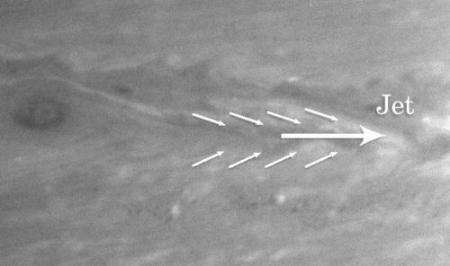Cassini Finds that Storms Power Saturn's Jet Streams

New Cassini research suggests eddies, or giant rotating storms, are the "engine" powering Saturn's jet stream winds.
"The new information about how Saturn's jet streams are powered is exactly the opposite of what we thought prior to Cassini," said Anthony Del Genio of NASA's Goddard Institute for Space Studies, New York, N.Y. Del Genio is a Cassini imaging team member and lead author of a paper describing this research in press in the journal Icarus.
Jet streams are motions in an atmosphere that carry clouds rapidly eastward or westward. The eddies get fed into the jet streams, in much the same way that rotating gears can power a conveyor belt.
"While we thought the conveyor belt--in this case, the jet streams--powered the rotating eddies, we now think the opposite: the rotating eddies power the jet streams," said Del Genio.
"Intuition would say that the eddies take energy out of the jets, because of the friction and tugging of the storms. Instead, what we find is that they are pumping energy into the jets," said Andrew Ingersoll, a Cassini imaging team member with the California Institute of Technology, Pasadena, Calif. Ingersoll says that while this process has been known to occur on Earth, it was only recently shown to operate on Jupiter and is a new idea for Saturn, where data from the earlier Voyager missions had failed to detect the eddy-jet interactions.
The Cassini team analyzed, for the first time, how storms and eddies interact with Saturn's jet streams. By tracking the movements of these cloud features in successive images separated by about 10 hours (about one Saturn rotation), Cassini scientists have confirmed that the eddies on either side of the jet give up their energy and momentum, which helps keep the winds in the jet blowing.
"We knew the eddies were powering the jets because they were pointing in the same direction and carrying momentum in that direction. If the eddies had been tapering the other way, we would have concluded the opposite," added Ingersoll.
The analysis of Cassini images covering most of Saturn's southern hemisphere suggests that similar processes are occurring all over the planet. This explains why Saturn's alternating pattern of eastward and westward jets has remained constant over most of the planet during the many decades that scientists have been able to observe it. The same process was also recently found to occur on Jupiter, in data obtained when Cassini flew by that planet on its way to Saturn. The process is a well known feature on Earth in the two jet streams that circle the globe in the northern and southern hemisphere.
The findings suggest that traditional ideas about the banded clouds of Jupiter and Saturn need to be revised.
"We used to assume that the bright cloud bands are regions where air rises and the dark bands are where air sinks. But if the eddies power the jets in the way we observe, the opposite must be true," said Del Genio. "And indeed, we find thunderstorms only in the dark bands on both planets, which has to mean that the air is rising there."
Source: NASA



















